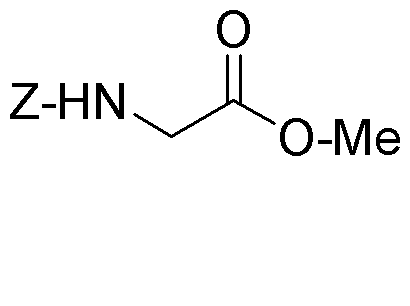Z-glycine methyl ester is widely utilized in research focused on:
- Synthesis of Peptides: This compound serves as a building block in peptide synthesis, allowing researchers to create specific sequences for studies in biochemistry and pharmacology.
- Drug Development: It plays a role in the development of pharmaceutical compounds, particularly in creating prodrugs that enhance bioavailability and efficacy of active ingredients.
- Bioconjugation: Z-glycine methyl ester is used in bioconjugation processes, linking biomolecules to improve drug delivery systems and targeting mechanisms in cancer therapy.
- Analytical Chemistry: The compound is utilized in various analytical techniques, including chromatography, to separate and identify complex mixtures in research and quality control.
- Research in Neuroscience: It is applied in studies related to neurotransmitter activity, helping researchers understand the mechanisms of action for various neurological drugs.
General Information
Properties
Safety and Regulations
Applications
Z-glycine methyl ester is widely utilized in research focused on:
- Synthesis of Peptides: This compound serves as a building block in peptide synthesis, allowing researchers to create specific sequences for studies in biochemistry and pharmacology.
- Drug Development: It plays a role in the development of pharmaceutical compounds, particularly in creating prodrugs that enhance bioavailability and efficacy of active ingredients.
- Bioconjugation: Z-glycine methyl ester is used in bioconjugation processes, linking biomolecules to improve drug delivery systems and targeting mechanisms in cancer therapy.
- Analytical Chemistry: The compound is utilized in various analytical techniques, including chromatography, to separate and identify complex mixtures in research and quality control.
- Research in Neuroscience: It is applied in studies related to neurotransmitter activity, helping researchers understand the mechanisms of action for various neurological drugs.
Documents
Safety Data Sheets (SDS)
The SDS provides comprehensive safety information on handling, storage, and disposal of the product.
Product Specification (PS)
The PS provides a comprehensive breakdown of the product’s properties, including chemical composition, physical state, purity, and storage requirements. It also details acceptable quality ranges and the product's intended applications.
Certificates of Analysis (COA)
Search for Certificates of Analysis (COA) by entering the products Lot Number. Lot and Batch Numbers can be found on a product’s label following the words ‘Lot’ or ‘Batch’.
*Catalog Number
*Lot Number
Certificates Of Origin (COO)
This COO confirms the country where the product was manufactured, and also details the materials and components used in it and whether it is derived from natural, synthetic, or other specific sources. This certificate may be required for customs, trade, and regulatory compliance.
*Catalog Number
*Lot Number
Safety Data Sheets (SDS)
The SDS provides comprehensive safety information on handling, storage, and disposal of the product.
DownloadProduct Specification (PS)
The PS provides a comprehensive breakdown of the product’s properties, including chemical composition, physical state, purity, and storage requirements. It also details acceptable quality ranges and the product's intended applications.
DownloadCertificates of Analysis (COA)
Search for Certificates of Analysis (COA) by entering the products Lot Number. Lot and Batch Numbers can be found on a product’s label following the words ‘Lot’ or ‘Batch’.
*Catalog Number
*Lot Number
Certificates Of Origin (COO)
This COO confirms the country where the product was manufactured, and also details the materials and components used in it and whether it is derived from natural, synthetic, or other specific sources. This certificate may be required for customs, trade, and regulatory compliance.


